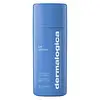What's inside
What's inside
 Key Ingredients
Key Ingredients

 Benefits
Benefits

 Concerns
Concerns

 Ingredients Side-by-side
Ingredients Side-by-side

Water
Skin ConditioningSodium C14-16 Olefin Sulfonate
CleansingCocamidopropyl Betaine
CleansingPEG/PPG-8/3 Diisostearate
EmulsifyingHydrogenated Jojoba Oil
AbrasiveAcrylates Copolymer
Vaccinium Myrtillus Fruit/Leaf Extract
AstringentSaccharum Officinarum Extract
MoisturisingCitrus Aurantium Dulcis Fruit Extract
MaskingCitrus Limon Fruit Extract
MaskingAcer Saccharum Extract
Skin ConditioningSalicylic Acid
MaskingGlycyrrhiza Glabra Root Extract
BleachingPanthenol
Skin ConditioningBisabolol
MaskingCitric Acid
BufferingGlycerin
HumectantEthylhexylglycerin
Skin ConditioningSodium Hydroxide
BufferingDisodium EDTA
Potassium Sorbate
PreservativePhenoxyethanol
PreservativeLavandula Angustifolia Oil
MaskingCitrus Aurantium Dulcis Peel Oil
MaskingMica
Cosmetic ColorantTin Oxide
AbrasiveTitanium Dioxide
Cosmetic ColorantWater, Sodium C14-16 Olefin Sulfonate, Cocamidopropyl Betaine, PEG/PPG-8/3 Diisostearate, Hydrogenated Jojoba Oil, Acrylates Copolymer, Vaccinium Myrtillus Fruit/Leaf Extract, Saccharum Officinarum Extract, Citrus Aurantium Dulcis Fruit Extract, Citrus Limon Fruit Extract, Acer Saccharum Extract, Salicylic Acid, Glycyrrhiza Glabra Root Extract, Panthenol, Bisabolol, Citric Acid, Glycerin, Ethylhexylglycerin, Sodium Hydroxide, Disodium EDTA, Potassium Sorbate, Phenoxyethanol, Lavandula Angustifolia Oil, Citrus Aurantium Dulcis Peel Oil, Mica, Tin Oxide, Titanium Dioxide
Sodium Cocoyl Isethionate
CleansingMicrocrystalline Cellulose
AbsorbentSodium Bicarbonate
AbrasiveSorbitol
HumectantZea Mays Starch
AbsorbentSodium Cocoyl Glutamate
CleansingSaccharomyces Ferment
Skin ConditioningOryza Sativa Starch
AbsorbentMagnesium Oxide
AbsorbentCitric Acid
BufferingTapioca Starch
Avena Sativa Kernel Protein
Skin ConditioningCamellia Oleifera Seed Extract
AstringentSilica
AbrasiveCocos Nucifera Fruit Extract
EmollientInulin
Skin ConditioningCassia Hydroxypropyltrimonium Chloride
Silybum Marianum Seed Oil
Skin ConditioningKaolin
AbrasiveLauryl Methacrylate/Glycol Dimethacrylate Crosspolymer
Papain
Skin ConditioningHyaluronic Acid
HumectantAvena Sativa Kernel Extract
AbrasiveHelianthus Annuus Seed Oil
EmollientAvena Sativa Bran Extract
AbrasiveGlycine Soja Oil
EmollientCitrus Aurantium Dulcis Peel Extract
Emulsion StabilisingVitis Vinifera Fruit Extract
Skin ConditioningCitrus Aurantium Bergamia Fruit Oil
MaskingAniba Rosodora Wood Oil
AstringentSalvia Sclarea Oil
MaskingEucalyptus Globulus Leaf Oil
PerfumingChamomilla Recutita Flower Oil
MaskingCucurbita Pepo Fruit Extract
Skin ConditioningCucumis Sativus Fruit Extract
EmollientPerilla Ocymoides Leaf Extract
TonicDaucus Carota Sativa Root Extract
Skin ConditioningSea Salt
AbrasiveJuniperus Virginiana Oil
MaskingAlpha-Glucan Oligosaccharide
CleansingTocopherol
AntioxidantCastoryl Maleate
Skin ConditioningCaprylyl Glycol
EmollientAllantoin
Skin ConditioningDiglycerin
HumectantMaltodextrin
AbsorbentLauroyl Lysine
Skin ConditioningArginine
MaskingSaccharide Isomerate
HumectantSodium Lauroyl Glutamate
Beta-Carotene
Skin ConditioningXanthan Gum
EmulsifyingEthylhexylglycerin
Skin Conditioning1,2-Hexanediol
Skin ConditioningHydroxypropyl Methylcellulose
Emulsion StabilisingDextrin
AbsorbentSodium Palmitate
CleansingSodium Chloride
MaskingAcacia Senegal Gum
MaskingSodium Citrate
BufferingWater
Skin ConditioningO-Cymen-5-Ol
AntimicrobialLimonene
PerfumingLinalool
PerfumingSodium Cocoyl Isethionate, Microcrystalline Cellulose, Sodium Bicarbonate, Sorbitol, Zea Mays Starch, Sodium Cocoyl Glutamate, Saccharomyces Ferment, Oryza Sativa Starch, Magnesium Oxide, Citric Acid, Tapioca Starch, Avena Sativa Kernel Protein, Camellia Oleifera Seed Extract, Silica, Cocos Nucifera Fruit Extract, Inulin, Cassia Hydroxypropyltrimonium Chloride, Silybum Marianum Seed Oil, Kaolin, Lauryl Methacrylate/Glycol Dimethacrylate Crosspolymer, Papain, Hyaluronic Acid, Avena Sativa Kernel Extract, Helianthus Annuus Seed Oil, Avena Sativa Bran Extract, Glycine Soja Oil, Citrus Aurantium Dulcis Peel Extract, Vitis Vinifera Fruit Extract, Citrus Aurantium Bergamia Fruit Oil, Aniba Rosodora Wood Oil, Salvia Sclarea Oil, Eucalyptus Globulus Leaf Oil, Chamomilla Recutita Flower Oil, Cucurbita Pepo Fruit Extract, Cucumis Sativus Fruit Extract, Perilla Ocymoides Leaf Extract, Daucus Carota Sativa Root Extract, Sea Salt, Juniperus Virginiana Oil, Alpha-Glucan Oligosaccharide, Tocopherol, Castoryl Maleate, Caprylyl Glycol, Allantoin, Diglycerin, Maltodextrin, Lauroyl Lysine, Arginine, Saccharide Isomerate, Sodium Lauroyl Glutamate, Beta-Carotene, Xanthan Gum, Ethylhexylglycerin, 1,2-Hexanediol, Hydroxypropyl Methylcellulose, Dextrin, Sodium Palmitate, Sodium Chloride, Acacia Senegal Gum, Sodium Citrate, Water, O-Cymen-5-Ol, Limonene, Linalool
 Reviews
Reviews

Alternatives
Ingredients Explained
These ingredients are found in both products.
Ingredients higher up in an ingredient list are typically present in a larger amount.
Citric Acid is an alpha hydroxy acid (AHA) naturally found in citrus fruits like oranges, lemons, and limes.
Like other AHAs, citric acid can exfoliate skin by breaking down the bonds that hold dead skin cells together. This helps reveal smoother and brighter skin underneath.
However, this exfoliating effect only happens at high concentrations (20%) which can be hard to find in cosmetic products.
Due to this, citric acid is usually included in small amounts as a pH adjuster. This helps keep products slightly more acidic and compatible with skin's natural pH.
In skincare formulas, citric acid can:
While it can provide some skin benefits, research shows lactic acid and glycolic acid are generally more effective and less irritating exfoliants.
Most citric acid used in skincare today is made by fermenting sugars (usually from molasses). This synthetic version is identical to the natural citrus form but easier to stabilize and use in formulations.
Read more about some other popular AHA's here:
Learn more about Citric AcidEthylhexylglycerin (we can't pronounce this either) is commonly used as a preservative and skin softener. It is derived from glyceryl.
You might see Ethylhexylglycerin often paired with other preservatives such as phenoxyethanol. Ethylhexylglycerin has been found to increase the effectiveness of these other preservatives.
Water. It's the most common cosmetic ingredient of all. You'll usually see it at the top of ingredient lists, meaning that it makes up the largest part of the product.
So why is it so popular? Water most often acts as a solvent - this means that it helps dissolve other ingredients into the formulation.
You'll also recognize water as that liquid we all need to stay alive. If you see this, drink a glass of water. Stay hydrated!
Learn more about Water